ArchiCAD is designed to automatically save project data periodically. In the event of an AC or system crash, project data can usually be recovered. AutoSave is described on page 150 of the AC9 Reference Guide.
Yes, it's a little late for a New in 9 post, but that's what happens when I pretend I'm going to tell you, briefly, anything meaningful about something as gigantic as a rendering engine. After all, it's the sort of thing people write books about.
Said book, by Dwight Atkinson, Canada's funniest Lightworks in ArchiCAD expert, is in the possession of Rill & Decker, or maybe me personally. So if you want to have a look, be my guest.
If you UNCHECK 'Use Cut Elements' Section Pens' in a section's settings, all the cut lines are drawn with one pen, and all the fill patterns are drawn with one pen. The background color becomes clear.
I usually want this box checked, so the distinctive section pens of elements can be seen, which aids model organization and usability. For wall sections, I think there are a couple of advantages to letting the marker set the section pens:
• Model elements can be transparent while fills still have opaque backgrounds. So I can mask stone veneer with a CMU fill, without using two fills. Under the current standard, the Fill Background Color Display Option is set to Transparent, which effects model elements and fills.
• Following from above, the A3 Display Option Combination could be eliminated.
• If you use black (15/11) pens for the section and color pens for added 2D work, it's easier to tell which is which. (Note: Elevation pens are unchanged.)
• I recommend a 5-weight pen for cut lines, unless the element is very thin; e.g., a counter. Using a thinner pen for the section looks better at 1/4" scale, but at 3/4" or 1" it looks weak. With uniform pens, you could have it both ways.
But I don't think we can do it. Certain objects, most prominently Wood Beam JAM9, have clever pen-related section behavior, which the uniform pen feature breaks. This is the wood beam at wall section scale; it knows to draw the X lighter:
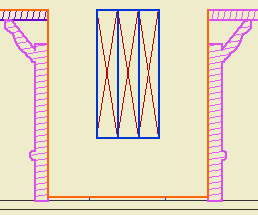
But the uniformity heavies up the X along with everything else:
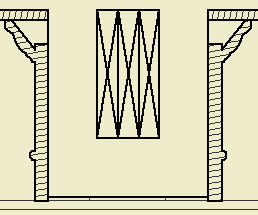
Which is no good, and it really can't be fixed without patches or conversion to drawing, so what's the point. You can always make a line heavier by drawing over it; lighter, not so much.
The technique might be beneficial for interior elevations, since it turns the gray background off. And interior elevations don't show structure members. We should look into it.
Hotlinked Modules are another Big Feature I can't describe fully before moving on to giving you the derivative techniques. There are several English/Hungarian bilingual people whose job it is to fully describe to AC interface so I don't have to. Their efforts can be appreciated starting on page 421 of the reference guide.
Again, I'll just hit the high points.
Hotlinked modules are external project data placed in a project. In the host project they are treated as a single, uneditable group, with hollow, square nodes. They can't be edited directly in the project where they are placed. They have to be opened separately. This is a good occasion for running two copies of AC. Hotlinked modules are one story at a time of solo projects, teamwork projects, or module files. (There is an annoying overlap of meaning between hotlinked modules and .MOD files.) You can place multiple stories of a project, but each is its own module, placed individually.
The default behavior is for AC to check hotlinked modules for changes when the project is opened. You can change this, but don't. You can also do a manual update using the Hotlink Manager. Changes in modules are reflected in the project once the update is complete.
The Hotlink Manager is at File -> Modules and XREFs -> Hotlink Manager. It is here that modules are placed, updated, broken (turned into local, editable elements), and changed.
Breaking a module results in one big group. If you ungroup this group, you will get the groups within, as they were in the original file.
Modules can be mirrored, elevated, and rotated. When a module is rotated, zone stamps and text blocks can rotate themselves to compensate.
Placing a module is completely different from merging a module file. When you merge, the elements become part of the project. Hotlinking is an ongoing external reference.
Only ArchiCAD files can be hotlinked. If you're placing DWGs, you need XREFs.
Applications to follow. Including:
Accessory structure alternates.
Energy calculations.
Showing a rotated garage level on the layout.
In here, where you can't see them, I have drafts of posts. The list of drafts can be viewed as the to-do list for the site. Stuff I know I have to tell you about, but I haven't gotten around to actually doing it. Many of the drafts relate to features of AC that are very powerful and proportionately complex. I don't want to regurgitate the reference guide, but I don't want to merely point you at the reference guide either. So there they sit. Since we're talking about powerful features, naturally there are other drafts of specific tips which have as prerequisites knowledge of the powerful features.
Anyway it's more important that you have the specific tips than the admirably balanced non-regurguitated, non-merely-pointing-you master post. Between the tips and the reference guide, you'll get the big picture. I hope.
One of these features is the Interactive Schedule (IS). We even had a meeting about it, since it's a lot easier to show and tell than to describe in text. I use the IS for door and window schedules, finish schedules, area calculations, and energy calculations. I also use is as a hack Find & Select for parameters within an object, so you can find all the crown elements that use WM-47 and change them to SM-28. Chances are some of these methods interest you, and I think they should, and I've been stalled in documenting them by the intimidating difficulty of the master post, which you'd think from the title would be this one.
So. The IS is documented in the reference guide beginning on page 374. Consider yourself pointed.
The ref guide does OK at telling you what the IS can do, but I think it's still up to me to point out its limitations. It is still very much a 1.0 feature.
• It only works in plan.
• It is modal, that is, you have to dismiss it in order to work in any other window, unlike, e.g., the Find & Select box.
• It can't do math beyond adding a column of numbers. No way to reduce an area by a percentage, e.g.
• The method for sharing schedule settings between projects is pathetic.
• It has too many poor interface quirks to list here.
It does what it does. In the future it will do more, and it's already way more accessible than the rest of the calculate menu.
More to follow.
PS, another big one is Hotlinked Modules. You need those for the energy calc thing I mentioned above. Sigh.
As of, I don't know, 8.1, Display Options can be organized into Combinations, kind of like layers, and Display Options can be saved with views. Our templates have been set up this way for some time, but I don't think I've ever cataloged the combinations. They're just as standardized as anything else. Highly.
In the DO dialog, there are two panes, Display Only and Display & Output.
The Display Only options do not vary among combinations. Real quick: Intersections are on, Walls are contour lines, all the handles are on, section depths, detail boundaries, and markup elements (never used 'em) are hidden.
Display & Output options is where the action is. Rather than describe each combination, or heaven forbid build a table, I'll describe the A1/A2 combination, then how the others differ.
In A1/A2, which gets saved with plans and elevations for output: Beams are Contour Lines (no reference lines), Line Weight is Hairlines (they get turned True in PM), all the Fills are Vectorial, Doors & Windows Show with Dim, Zone Polygons are None, Zone Stamps Show, Section Markers are As in Settings, Column Symbols Show, Fill Background Color is By Element Setting.
Working Plan/SED is the same as A1/A2 except Beams are Entire Beam (ref lines on), and the Drafting and Cover Fills are Bitmap.
A3, which gets saved with wall sections, is the same as A1/A2 except the Fill Background Color is Transparent. (This means no fill backgrounds. Use Solid Fill for white masks. To mask with a pattern fill, you need two overlapping fill elements.)
A4/S0/M/P, which gets saved with RCPs, mechanical, plumbing, and foundation plans, is the same as A1/A2 except the Doors & Windows are Reflected Ceiling.
S, which gets saved with framing plans, is the same as A4/S0/M/P except the Cut Fills are Separators only. This turns the wall fills off, but shows a line at the joint between, e.g., concrete and stone. Fill backgrounds are on, so masking fills will work.
Site, which gets saved with site plans, is the same as A4/S0/M/P except the Cut Fills are No Fills. You will only see the effect of this if you show walls on the site plan.
A quirk of DO Combination management: You can't rename them. You have to Save As, which leaves the old one in place, and then you have to redefine the views that use the renamed combination. Then you can delete the old-named one. Also, I haven't figured out how to import DO combinations from other projects.
Suddenly, Richard's AC could not open a file on the network, and would hang (rainbow ball of death) when attempting to browse a network resource, such as the Hotel. We noticed it when attempting to open another project in Attribute Manager; since the previous state of that Open dialog was viewing the Onion, hang.
All conventional treatments exhausted, I had to call tech support. They directed me to this knowledge base article, which has to with switching off a cross-platform browsing preference that we don't need anyway.
If you ever see this behavior in AC, here's the fix.
Make sure AC is not running. Open Terminal (Applications : Utilities : Terminal). Paste this text into the window, replace the [square brackets] with angle brackets* (Shift+, and Shift+. respectively) and strike enter:
defaults write com.graphisoft.AC\ 9.0.0\ USA\ v1 InputOutput -dict "DisableCrossPlatformMountingFeatures" "[true/]"
That's it. Quit Terminal and relaunch AC.
* There must be a way to escape the angle brackets in here but I don't know it.
If you drag a dimension string, the texts will re-center themselves on their segments, assuming the texts have not been moved manually.
You don't actually have to drag the string anywhere, just a drag and a double-click will do it.
The only way a dim text would be off center without you moving it is if you customized the text.
Who cares? You, because you probably changed some texts to read EQ or something, and re-centering them by hand is a cumulative chore.
So, after changing the texts to read whatever, (deselect the texts,) select the string, Cmd+D, clickclick. Note: if the dimension tool is active (very likely), you have to do a Drag command; cursor-drag will edit the witness line length. You can drag with the arrow tool and it works; I think the Cmd+D method is better since you don't have to be precise. Any texts that you moved manually will stay put. AC remembers which those are.
I just dimensioned all the Vassos ceiling lights on the electrical plan, which, if you've never had the pleasure, boils down to a LOT of EQ EQ EQ EQ EQ. So I was really happy with this discovery.
Sort of cross-posted here.
(Originally posted here. Added examples.)
Here is the Geometry Methods info box tile.

Geometry Methods are the ways of making a shape with a tool. The 'GMs' are only available in the info box, not in the settings. You can switch geometry methods in any tool by typing G.
The first button is one click placement. The object will be created with the default X, Y, and rotation. Example: A recessed light fixture, since it's not stretchy and it doesn't matter how it's rotated.
Second is rotated placement. Two clicks. First is anchor point, second is angle. X & Y will be the defaults. Examples: Anything that you would turn to face a certain direction. A lot of things. Sinks. Light switches. Sconces. Centerline symbols.
Third is rectangle placement. Two clicks. First is anchor point. Second is the diagonally opposite point. The same method is available for polygons (slabs, fills, etc.) Not all objects will be placable this way; only stretchy* ones. By this method you can graphically set X & Y, but you can't give values. Example: Crown Tool in coffer mode.
*Interlude: Stretchiness. Objects are stretchy if they have hotspots in their 2D scripts at the 0, A, & B extents, OR "Hotspots on bounding box" is on in their "Details". Don't worry about this now. An example of a stretchy object is Bed 01 in the Furniture folder. The only way to know if an object is stretchy is to try it, or look in the script. Most rectangular objects should be stretchy.
For "stretchy" placement to work, you have to have a corner set as the insertion node in the settings. If a non-stretchy node (e.g., the center) is the insertion node, you get one-click simple placement. In the plan preview window in the object settings, the insertion node has a box around it. You can choose a different insertion node there by clicking on it.
Tip: When you Option-click (pick up settings) on an object, the node you clicked becomes the insertion node.
The fourth button is rotated rectangle. Three clicks. First is the anchor point. Second is angle AND length of first side (X). Third is length of second side (Y). Example: Crown tool coffer in a rotated space. The same method is available for polygons. If a non-stretchy node (e.g., the center) is the insertion node, you get two-click rotated placement.
The key is not to get hung up on "rotated". I use this method all the time for non-rotated polygons, because you can use R to set the length of both sides on the fly. Example: counter slabs. When placing an object such as a bathtub this way, you need to know which way the object goes; X is first, Y is second. If you do it backwards you get the drain on the long side.
If an object is "linear", only stretchable in one direction, stretchy placement still works. If using rotated placement (4th), the second click only sets the angle, and the third click sets the length. Using the fourth button with a linear object enables you to draw it very much like you would a line. Examples: Lots. Drawing title, crown tool in straight mode, steel and wood beams, cut lines. Sometimes it's hard to predict which side of the "line" an object will be drawn; if it's wrong just mirror it.
Choosing the right geometry method saves a lot of after-rotating and -stretching, and is therefore much faster.
I was going to patch up this post, but I decided to do a new one. The old one is mostly right, I just wanted to add...
• In AC9, there is a menu command for Create Independent Detail. That means you can have a shortcut for it. In our keyboard setup, it's Ctrl+D. (What. Oh. Tools menu. Please don't do it that way. I hate menus.) Also nice, when you create an independent detail, it opens automatically.
• For some reason, most of my projects open new independent details at absurdly zoomed-out views. Like the window is a million feet across. I can't fix this, it's not stored in the prefs. It's always a good idea to work near the origin. You can zoom to the origin quickly by placing an object there and then doing a fit it window.
• Wall sections should be Sections. It's so clear to me now.
• IDs. They still need to be unique, but the ID will now take up to 31 characters, so you can be very non-cryptic. You can have spaces, though I don't use them. I like it to be clear that the first word is the ID. To review, use the ID to say what type of detail is in there, with a number so maintain uniqueness. Use the name for a fuller description. Eave1 Typical, Eave2 Shed, Eave3 Porch.
I have been drawing all the engineering details myself, based on their sketches. I keep these separate by beginning all their IDs with "S_".
• Detail markers: For areas, use Detail Area JAM9. For flags, use Detail Flag JAM81. These markers show the ID in ArchiCAD and the drawing/sheet number in PM layouts. For assemblies, use Assembly Marker JAM81. This marker maintains the ID, which is the same as the (non-autotext) drawing number in each assembly detail. It also gives the sheet number, which is automatic. I have developed the habit of putting my schedules and assemblies on sheet A3-1, so they stay put as sheets are added.
• Remember you can open a detail from any marker, not just the original one.
• The biggest hassle with the detail tool is the fact that you can't put a detail marker in a detail window. Maybe someday. If you need to call out a detail within a detail, use an object. Remember the autotext referencing hack.
Another Hotfix. It's on the Onion, next to the previous one. Here is the list of fixes. I was tragically victimized by the disappearing label thing, so good.
Again, Everyone should run this. Again, You can run it from the Onion, rather than copying it to your machine.
Again, (You can check for updates any time by choosing Check For Updates from the Help menu in ArchiCAD.)
I love the clipboard. I won't paste in my rant about the version numbering, although it still applies. Yup, 9.0.0 v1, now and forever. Watch that build number though.
Take the ArchiCAD competency test. Whee.
I thought it was pretty tough. I managed an 86.
House rules: Since each question is timed (90 sec), I think open book/open ArchiCAD is permitted. If you can open the Attach XREF dialog and figure it out in 90 seconds having never looked at it before, more power to you. The point is to learn anyway.
Unfortunately, they don't tell you which things you got wrong. You'll probably have a feeling though.
I just realized I never mentioned this. I don't use it very often, but that doesn't mean you shouldn't.
In all of the library part settings dialogs, you can search for library parts by keyword.
At the upper left click 'Folder View' and choose 'Find Library Parts'.
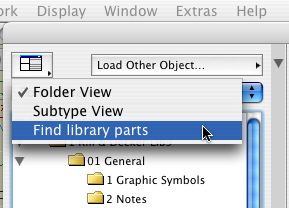
Enter the keyword(s) and click 'Find'. Resist the temptation to strike return; that will close the dialog. You can also refine how the keywords are searched for and limit the search to certain libraries.
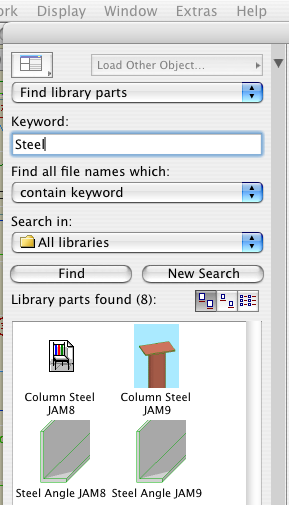
The matching objects are shown. If you highlight an object and then switch back to 'Folder View', you will get the folder of that object.
When selecting objects this way, be careful to use the most current version. The find function will show objects in the 'xOld RND' folder the same as any other. Make sure not to choose them by accident.
Q
When I paste elements, is there a way to select those elements?
A
Complete the paste. Undo (Cmd+Z). Redo (Cmd+Shift+Z).
Q
Working in section, is there a way to reveal selected elements in plan?
A
Yes.
Q
How can I tell what elements were affected by a marquee stretch?
A
Undo, redo. The affected elements are selected. Current story only, natch.
When an editing action is undone, the edited element will typically be selected. Comes in handy.
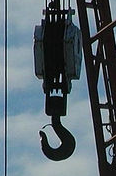
Elevate, v. syn: lift, hoist, raise, pull up...
It's slow to open the settings dialog when you can use the info box.
It's slow to choose File -> Save rather than typing Cmd+S.
It's slow to choose File -> Merge rather than typing Opt+M.
It's slow to hunt down the close button at the top of a window rather than typing Cmd+W. However: it's slow to bring a window to the foreground so you can close it, if you can click its close button in the background.
It's starfish-slow to choose Edit -> Copy, choose Options -> Stories -> Go Up A Story, choose Edit -> Paste, rather than holding down Cmd and typing C, 6, V.
It's canyon-formation-slow to choose Tools -> Display Order -> Bring Forward, Tools -> Display Order -> Bring Forward, Tools -> Display Order -> Bring Forward, Tools -> Display Order -> Bring Forward, rather than holding down Ctrl and typing 6, 6, 6, 6.
It's slow to right-click and choose Undo, right-click and choose Undo, right-click and choose Undo, right-click and choose Undo, right-click and choose Undo, rather than holding down Cmd and typing Z, Z, Z, Z, Z.
It's slow to drag windows around until you see the one you want rather than use Exposé.
It's slow to go to Display Options when you can use this.
It's slow to go to the Project Map, scroll to the Details part, right-click on it, and choose New Independent Detail, rather than typing Ctrl+D.
It's slow to right-click and choose Open Section/Elevation, or Last Section/Elevation, but unfortunately we don't have a choice.
The fastest way to cancel anything is to type Esc.
The fastest way to deselect is to type Esc.
The fastest way to remove marquee is to type Esc.
The fastest way to switch to the Arrow is to type Esc. The second fastest way is to type Right Arrow, and that's better a lot of the times because it doesn't require that you have no selection and no marquee.
The fastest way to activate the Marquee tool is to type ` (the key above Tab).
The fastest way to activate the Wall tool is to type 1.
The fastest way to activate the Slab tool is to type 2.
The fastest way to activate the Roof tool is to type 3.
The fastest way to activate the Text tool is to type E.
The fastest way to activate the Fill tool is to type F.
The fastest way to activate the Door or Window tool is to type D or W respectively.
The fastest way to change the reference line side of a wall is to type C.
The fastest way to change the geometry method (box, rotated box, polygon, etc) of any tool is to type G. It's also the fastest way to switch the orientation of the dimension tool.
The fastest way to turn on gravity and choose the gravity element type is to type V.
You can do all those things without moving your left arm. You have to move your left arm a little, but it's still fastest to
...activate the arc tool by typing 0 (zero),
...activate the Object tool by typing (letter) O,
...activate the line tool by typing L,
...activate the Dimension tool by typing /.
...toggle the rotated grid by typing K.
There are different ways of doing this, but the first I've been pleased with is the use of Quicksilver.
With Quicksilver running, invoke it (Ctrl+Space, unless you changed it). Type enough of the word "ArchiCAD" to have it pop up on the left. If you have multiple versions, select the proper one from the list below.
Tab. Type "Lau". You should see "Launch Another Copy". Return.
There ya go.
If you don't see the "Launch Another Copy" option, quit Quicksilver, relaunch it, and try again. I have seen this happen after launching another copy, quitting it, and trying to launch again. Seems like a bug.
It isn't needed, but there are times when it's very convenient. You can quickly copy and paste from another project. You can open a placed module without closing the host project. It comes in handy.
Run multiple copies at your own risk. Keep your head on straight. Don't run two all the time. Don't open the same file in two copies at once. Quit the second one when you're done with it. Pay attention to where the second copy is on the dock. All these warnings go double for people who are easily confused, you know who you are.
Another tip: When quitting two ACs, let one quit all the way (the black triangle disappears from the dock) before quitting the other. If you quit them both simultaneously, you're asking for corrupted preferences.
There is a bugfix, they call it a Hotfix, I don't know what that means, update to ArchiCAD. The updater is on the Onion in ArchiCAD Program Files. It's called AC9-1965.
Everyone should run this. You can run it from the Onion, rather than copying it to your machine.
(You can check for updates any time by choosing Check For Updates from the Help menu in ArchiCAD.)
Here is the list of fixes. Most of them don't mean much to me, hopefully some of our (unlisted) issues have been fixed too.
It has been out for several days and no one has complained yet, so it probably does no harm.
Graphisoft's version numbering scheme has become completely ridiculous. Patches like this one should increment the third digit in the version number, making this 9.0.1. But no, they have this quirky "v1, v2" patch numbering deal, but they don't even use that consistently. Sometimes a patch increments the v number, sometimes it adds a "+", and in this case it does nothing, it's still v1. So it's not 9.0.1, it's not 9.0.0 v2, it's not 9.0.0 v1+, it's 9.0.0 v1 Build 1965. You have to know the build number, which should be a really geeky arcane thing, in order to describe the standard current release of the program. Most people outside of software development don't know what a build number is. Ridiculous.
Gravity allows you to "set" elements on top of other elements. Instead of manually setting a Z height, the element will be placed at the top elevation of a slab, roof, or mesh, at the clicked point.
These elements can be placed using gravity: Wall, Column, Beam, Object, Lamp, Level Dimension.
I works in plan and in the 3D window.
You tell ArchiCAD what type of element to set on by using the gravity buttons in the Coordinate Box:
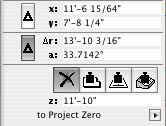
L-R: Off, Slab, Roof, Mesh
You can scroll thru the buttons by typing V.
If more than one of the target element type is present at a given point (e.g., floor, counter, and ceiling slabs), the placed element will be set on top of the topmost element. Elements on stories above will be detected too. In order to get gravity to detect lower elements, you can hide the layers of the elements that are "in the way." (Don't forget the Quick Layers palette.)
Tip: Watch the Z field of the Coordinate Box. It will display the elevation that gravity is using at a given point, so you can see if the element is going to be dropped at the right height.
In practice, I only gravity for a couple of things. It's not convenient to use it to place toilets, for example, since they have to sit on the finish floor, and the toilet usually goes in before the finish floor slab. Since gravity always responds to the topmost target element, it takes some planning and care, and it isn't as natural as it could be.
It's very useful for placing 3D trees on a mesh. No matter where you click, you know the tree is going sit on the mesh, and you don't need to know the height.
It's indispensable for associated Level Dimensions.
Composites allow you to show multiple cut fills in a wall, slab, or roof. I can think of three reasons to use them.
• To display multiple fills. Example: Masonry veneer on a stud wall. This is the most obvious, and probably original, reason to have them. Ironically, such composites don't work at all unless you've made your own windows to handle the masonry openings correctly, which we have.
• To model a wall at one thickness while dimensioning the wall to another. Example: 2x4 with drywall. The wall is 4 1/2" inches thick to match reality, and to properly interact with trim elements. We dimension only the stud portion of the wall. More on the particulars of this below.
• To have elements "break down" nicely when turning a section into a drawing. Example: A joist deck. The deck composite has a skin for sheathing on top of a thick skin of the joist depth. The skins are the same fill, so the slab will appear homogeneous. When the section is unlinked, it's easy to turn the top (sheathing) fill into plywood. Since composites don't have scale-sensitive fills, this is the next best thing.
Composite setup
• Edit composites at Options -> Attribute Settings -> Composites.
• Composites can 'force' skin attributes onto elements. Instead of setting each wall to have particular pens for background color, skin lines, etc., you can set elements to use the attributes defined in the composite. Generally, I think this is a good idea, on the principle that you should control more stuff with fewer clicks. Further,
• There is a special case where you have to use the settings of the composite: To completely hide a skin separator line. This option isn't available in the element settings. For drywall partitions, you have to treat the interior separator lines in this way.
• The background colors, fill pens, contour pens, and separator pens can be applied from the composite independently. If you want a wall to be blue for some reason, you can change the contour (cut) pen while retaining the background color of the composite.
• You can limit the use of a composite to the wall, slab, and/or roof tools.
• For wall composites, the reference line is at the top.
• As with any attribute, you can use Attribute Manager to pull composites from other projects.
Case study, dimensioning stud walls
• In the setup of the composite, the checkboxes on the left allow you to designate skins as "Core". You can have multiple core skins, but they must be adjacent. What's core? Well,
• In the dimension tool settings, there is a checkbox, "Dimension Core Only of Composite Walls." So,
• The composite 'Wall 2x4 DW' has only the 3 1/2" center skin set to core. When dimensioning, click on the edge of the wall. (Don't hunt for corners!) This results in two ticks on the core, not the outside, of the wall. The wall is built at 4 1/2", and dimensions 3 1/2". Perfect.
• Summary of why this composite set up the way it is: It's 4 1/2" inches overall, because that's how thick walls are in real life, and it's impossible to pretend otherwise and still get the trim modeled correctly. It's three skins; 3 1/2" in the middle, set to core, so we can dimension to the framing. The three skins are all the same fill, so the walls clean up to the slabs in section. (The slabs are all the same fill too.) The separator lines are hidden in the composite settings, so the walls clean up to each other in plan.
Click the flyout on the favorites palette and choose "Load Favorites". Navigate to the favorites file you want. We keep general favorites at 3 Resources : Favorites.
If you already have favorites in the list, you will be asked if you want to Merge or Replace the existing favorites. Unfortunately, "Replace" refers to the list as a whole: All the current favorites will be deleted. To overwrite current favorites with those in the new file, while leaving the others alone, you need to choose "Merge." This has its own quirk: When a matching name is found, you will be offered the options "Skip" (don't overwrite), "Skip All" (which cancels all remaining overwrites), and "Overwrite". There is no "Overwrite All", so in order to accept all the incoming favorites, you have to click "Overwrite" however many times. Another D-minus interface element.
Also, I can't stand the word "favorites". It means I have a great subjective, emotional, aesthetic interest in the item, much greater than in most items. "OMG, I loooooove this 2x4 wall!!!" No. They should be called presets.
You can drag and drop libraries to the Library Manager from the Finder.
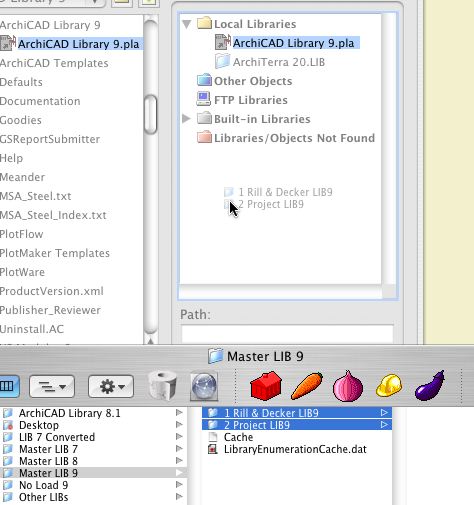
Like this
I'm sure I've mentioned this somewhere...
Since AC8, objects have had the ability to have nodes that edit parameters other than height and width. In GDL jargon, this functionality is called Graphical Editing. These nodes respond to the stretch command as well as the stretch button of the pet palette. Even though they can do things besides stretch.
Since AC8.1, editing nodes have been diamond-shaped instead of round, so you can tell them from the non-editing ones.
In AC9, they decided that wasn't clear enough, and now editing nodes can have a different color. (Options -> Preferences -> Miscellaneous) The default is green, and I haven't been motivated to change it. When you see a green, diamond-shaped node, try it and see what it does.
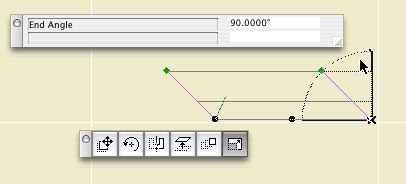
Editing a crown miter
While editing with one of these nodes, a palette pops with the name and value of the parameter(s) being edited. (Some nodes edit two parameters at once.) If you type "N", the value in the palette will highlight and you can enter the value directly, just like typing "R".
In Library Manager, the History tab shows the libraries that have been loaded recently (since the last Clear or Clear All). This list is independent of any particular project.
Typically we use the exact same libraries all the time. But there are exceptions; sometimes you need the version 7 library, for example. If you've loaded that library recently, you can add it from the history tab instead of scrolling through the whole Local/LAN tree.
It's also helpful if you take projects home. When you open a project in a different location, the library manager will come up because the servers aren't there and your local ArchiCAD folder path is different. But the history tab remembers the local instances of the libraries, making it easy to load them quickly.
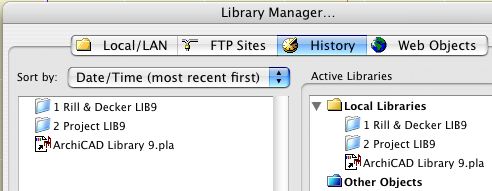
If you load a "wrong" library at some point, you can use the "Clear" button to delete it from the history so you're not tempted by it in the future.
A particularly self-starting member of the ArchiCAD community, Karl Ottenstein, has developed an add-on called QuickDisplay, which allows us to assign keyboard shortcuts to various display options. The commands are toggles, which means you can strike a key turn the Section Depth (e.g.) on, and then strike the same key to turn them off. He has generously allowed this add-on to be used free of charge. Here is the ArchiCAD Talk topic where mad, righteous praise is heaped upon him.
Here is Karl's page with full instructions for the add-on. I will summarize the high points.
Get the file from 3 Resources : Add-Ons. Place it in your local Applications : Graphisoft : ArchiCAD 9 : Add-Ons. Launch or relaunch ArchiCAD.
Your Display menu should now have a QuickDisplay submenu at the end. Here you will see commands for toggling various display options.
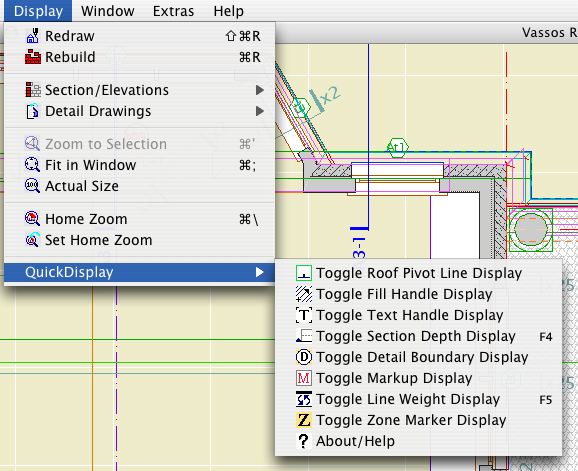
QuickDisplay Submenu
Naturally, and I hope obviously, you don't go to this menu to activate the commands. That wouldn't be much of a shortcut would it. The commands have to be on a menu in order to have shortcuts assigned to them.
As you can see, I only have shortcuts assigned to two of the commands, Section Depth and Line Weights, on F4 and F5 respectively. I toggle the others much less and I don't need a shortcut for them. You can do whatever you want.
I have updated the RND Keyboard scheme with these two shortcuts. You can import the updated scheme at Options -> Work Environment. The scheme is located at 3 Resources : Work Environment : RND Profile : Shortcuts.
For information on assigning shortcuts, see the ArchiCAD Reference Guide, page 153, or ask for help.
Well, there's not much to it. While moving from 7 to 8 was so awkward we had to decide if it was worth it, moving from 8 to 9 is so simple it's hardly worth writing down. The only extra step is to import the Work Environment.
You should be able to simply open your 8.1 project in AC9. You should be able to open your PM 3.1 layout book in PM9. If you don't change the name of the project file, the views should update in PM without fanfare.
That said, I wouldn't make the jump the day before the construction set is due. Use common sense.
Just in case, put a copy of the project in your Old Files folder with a modified name. Don't change the name of the working version of the file. If you do, you'll have to relink in PM.
Libraries: Switch your libraries so the following are loaded:
� From the carrot, within Master Library 9, '1 Rill & Decker LIB9' and '2 Project LIB9'.
� 'ArchiCAD Library 9' from your local Applications : Graphisoft : ArchiCAD 9 : ArchiCAD Library 9. (We load the ArchiCAD Library locally because it's faster and it never changes, so there's so synchronization issue.)
Stop using the Master Library 8 entirely. If you are working with a AC7 project that has been brought forward, continue to use the 7 library as you have been.
On the subject of the cache library, there are intermittent issues with it. If it works for you, use it. If not, don't. If you have weirdly missing parts, this is the first thing to check.
For the new Master Library 9, I copied the whole Master Library 8 to start, and I have been updating and replacing some parts along the way. As version 8 parts get superseded, I move them to the 'xOld Objects' folder. This folder loads, so you can keep using the placed parts indefinitely. For new placements, you should use the newer objects in the normal folders. To remind you, the 'xOld Objects' folder is a jumbled mess, making it very hard to find anything. Don't try.
If you have missing or misbehaving Library Parts, it's probably a change that was made in the 8 library that didn't get copied to the 9 library. You should immediately let me know of any issues so we can dispatch them right away.
This post ties together all the AC9 posts.
Overall AC9 is very much like AC8. Superficially it is almost identical. The changes primarily concern interface and performance.
Performance means it runs faster and better. Interface means:
• Selection is improved. Quick Selection lets you select virtually any element without finding a detectable edge or node. Escape deselects. (Without a deselect function, that QS thing would be a very mixed blessing.) Cmd-Shift restores the old caps lock functionality, letting you 'scroll' through a pile of coincident elements. Objects can have detectable edges. Select with a box under any tool by holding down Shift. To select with a box over a QS-able element, hold down Shift and the spacebar.
• Less switching between tools. The unified pet palettes mean it doesn't matter which tool is active, and the palette commands work better. There are also polyline/polygon editing improvements
• You can switch objects without all the settings reverting to default. There's a search field in the Object (etc.) Settings dialog.
• The Work Environment is much easier to customize, save, distribute, restore. We have toolbars, yay.
Interface changes may seem superficial, but together the whole working experience has been smoothed out and is much more efficient.
There are a few welcome tool improvements. We finally have cover fills on model polygons. The Text tool is utterly transformed. Optional section rebuild is nice, but be careful. Dimension settings is one of those things that's deadly boring until it bites you, so it's good that views now take them into account.
PlotMaker is still PlotMaker, poor thing.
That's all the big stuff. You should peruse the New Features Guide, which is in PDF format on the installation CD, and at 3 Resources : Documentation.
I would have called it 3.2. Others have suggested 3.5. A few very charitable souls say 4.0 would be OK.
9 it's not. To me having the version number the same implies functional parity with ArchiCAD, which makes me laugh, but only to keep from crying.
There are precious few interface improvements. One I do appreciate: In Drawing Usage, drawings on the active layout are shown bold. It also has toolbars, and I use the one with Print and Plot on it so I don't have to keep the various interpretations of Cmd+P straight.
The performance of importing drawings is noticeably better, and that is always welcome.
Other than that, it's still a hillbilly. Dragging a copy is still different, the marquee is still different, no split, no adjust, no Info Box, bla bla !@#$% bla.
So let me be the first to dash your hopes that the '9' signifies anything at all. Sorry.
PS, that hotspot glitch, where the hotspots go dumb after you stretch a frame? Not fixed. You can't believe it either!
The installation process is pretty ordinary. The eye candy is a nice touch. I just want to point a couple things out.
Anywhere in the instructions where it talks about removing the hardware key, ignore it. (Leave the key in.)
It doesn't matter whether you do the key update or the installation first. Obviously 9 won't actually run until you do the update.
You can do 'Typical' installation. The 'Custom' option doesn't allow enough customization anymore, so skip it.
The default install location is now Applications -> Graphisoft, rather than Applications. I'm leaving it there.
I think desktop shortcuts are stupid. If you agree, remember to uncheck the boxes about them at the end of the install. Dock shortcuts are naturally superior.
The documentation PDFs don't install automatically. After the installation finishes, copy the 'Graphisoft Documentation' folder from the CD to the new ArchiCAD 9 folder, within Applications -> Graphisoft. Change the name to simply 'Documentation', or the docs won't show up in the help menu.
The first time you open AC9 it will look weird until you fix your Work Environment.
AC9 gives the option of Windows-style toolbars. I am among the least excited about this feature, since I think mousing around clicking on things is a waste of time when you can use the keyboard, which unfortunately isn't always.
It is my responsibility to point the feature out, and you may do with it what you wish. It is possible to build a toolbar from scratch for just the things you really need, which sounds like good idea, but not good enough to actually do it yet.
I use the Attributes toolbar,

...but only because they broke my keyboard scheme for Attributes.
I also have the Window Switcher in my palette scheme,

... which sort of gives you access to all the windows in the project, except it has crippled detail and section lists, and I haven't really developed the habit of using it.
Toolbars can be turned on and off at Window Menu -> Toolbar Display. You can customize toolbars in the Work Environment. The display and position of toolbars is saved with the Palettes scheme.
Like the new Text tool, the Work Environment is too complex for me to give an exhaustive treatment here. Refer to page 147 of the manual, or page 80 of the New Features Guide, for the full story. Briefly:
All of the user-related options in ArchiCAD and PlotMaker have been gathered together under the Work Environment, accessible on the Options menu. (Shift+Ctrl+~) This includes the keyboard shortcuts, the palette shapes and positions, the toolbox layout, the toolbars, the info box, even the menus themselves.
In addition to having these settings organized, and having more interface elements customizable, all of the environment settings can be saved and imported, making it very easy to set up the environment when a new version comes out, or if you have to delete the preferences.
I have set up a work environment which represents my best efforts at customization through the beta period. You should import this environment when you begin to work in AC9.
(Everything about importing the Work Environment also applies to beginning in PlotMaker.)
To import the environment:
1. Go to Options -> Work Environment. Click 'Import'. Click 'Browse' and navigate to 3 Resources (the Onion) -> Work Environment -> RND Profile.
2. Back in the Import dialog, select the profile and click 'Import'. You should now see 'RND Profile' in the Stored Profiles list.
3. Double-click the 'RND Profile' profile. This applies the schemes of the profile.
4. With the 'RND Profile' profile highlighted, click 'Set as Default'.
You can customize any of the environment components you like. A few thoughts:
� The palette arrangement is for a 23" Cinema Display. It will be a few more days until everybody has one, so some palette experimentation is probably in order. Palette layout is also a very subjective area where reasonable people may disagree. My only tip is that it is better to make an arrangement and stick with it rather than constantly push things around. After you arrange palettes, click the green button on the 2D and 3D windows to get them to conform to the palette positions. Then resize the windows how you like.
� Please refrain from deleting keyboard shortcuts. AC9 has the option of having multiple shortcuts for a single command, so if you want to try something new, just add it rather than replacing.
� More on keyboard shortcuts (Yes, it is one of my favorite topics.): AC9 finally allows the use of the F1-F15 keys on the Mac. We've lived without them for so long that it's hard to know how to react. I have the group switch on F1 and the ghost story display on F2, in addition (see above) to the old Opt+G and Cmd+8. Beyond that I don't know.
� Customizing menus looks like a massive time sink. It does give me another opportunity to say, don't waste your time going to menus, use the keyboard. I have not customized my menus at all, because by and large I don't know or care where on a menu a command is, because I rarely get them that way.
� Don't mess with the Info Box. I have invested a fair amount of time in refining it, and the result is the definitive optimization, probably in the world. Serious! Ask to see the spreadsheet. It is designed to be vertical, one tile wide, long enough to show all the tiles on the most complex tool. (You have to guess.) If/when pushing palettes around, keep the Info Box in this shape.
If you make changes in a scheme: In order to get the changes to stick you have to highlight the top level of that scheme, then highlight your scheme name on the right and click 'Redefine'. Example: You modify shortcuts under 'Keyboard Shortcuts', but to save the changes you have to highlight 'Shortcut Schemes'.
Cover fills are the long, long, long-awaited ability of model polygons (slabs, roofs, meshes, zones) to display fills in plan.
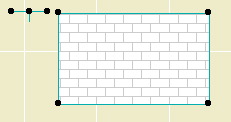
A roof and nothing but a roof.
This going to mean a lot less drawing over things to show fills and to get elements to hide one another.
Cover fills have all of the features of regular fills, including background pen, local origin, and rotation. Roofs can automatically rotate the fill pattern to align with the roof slope. You can set the cover fill to be the same as the vectorial hatching on the 3D material.
Display of cover fills is controlled by a new display option.
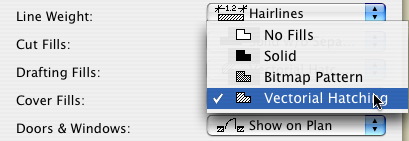
Selecting 'No Fills' puts the model polygons the way they were in AC8.1.
Notice that there are now a total of three fill display options. Further, 'Polygon Fills' has become 'Drafting Fills' and 'Construction Fills' has become 'Cut Fills'.
The distinction between Cover, Cut, and Drafting fills is called the Fill Category. You need to be aware of this because you can actually draft a cut or cover fill, which will display according to the relevant display option.
In Options -> Fill Types, you can limit the categories a fill can be used for. For example, shingles can't be used for cut fills.
Since you can set the category in the fill settings, and not all fills can be used for every category, you may find in a certain case that some fills are "missing". If so, check that the fill category in the settings is "drafting".
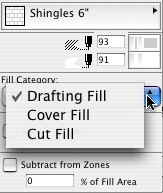
Fill Category in Info Box
AC9 brings the ability to save views with different dimension settings. The most prominent example would be the desire to dimension plans with feet & fractional inches, and site plans with decimal feet. Now you don't have to switch dimension settings back and forth, or explode dimensions, or other such tedium.
To make it easier to maintain the dimension settings, we use the long-standing, little-noticed Dimension Standards.
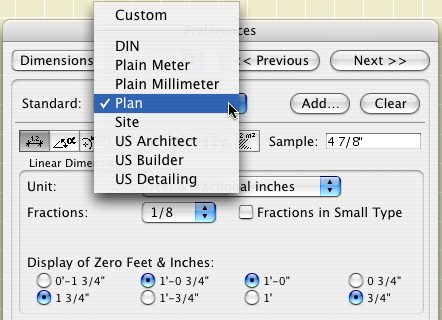
"Standards" in Dimension Preferences
There are two standards which we use in our views. "Site" is used for site plans. "Plan" is used for everything else. You could also set a standard for details if you wanted to display smaller fractions.
The view sets in the templates are configured to use the appropriate standard. For running projects, you will have to redefine your site plan views. Set the "Site" standard in the dimension settings, then redefine the view. (It's just like changing the scale or the layers.) Your plans should be OK, but it never hurts to check.
So now, views save scale, layers, display options, zoom, and dimension standard.
The GDL implementation in AC9 adds the option for the object designer to make edges detectable in plan for the purpose of selection.
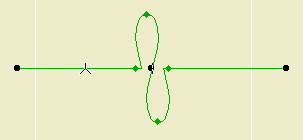
Detecting Cutline JAM9
This ability can be added to any line or arc. I'm working it into the libraries gradually, going for maximum convenience and minimum nuisance. In addition the cutline above, all the JAM9 trim tools are detectable by the front edge. This should make easier to select trims, which tend to coincide a lot. I am listening for suggestions.
Look closely at the image above and you will see that the special snap points (midpoint, etc.) show up on these edges.
Remember that this is only for detection. There's no polyline editing ability. You can use such edges for splitting and adjusting, but not Cmd+clicking. (Yes, I reported that.)
Text editing in AC9 is completely overhauled, one of the few features that is.
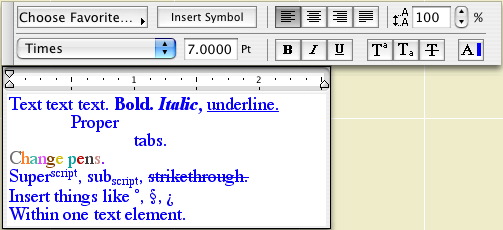
Different.
The changes to the text tool are too great for me to cover here. Generally, it is more like editing in Word. All of the typical variations in text are available, and the shortcuts for bold (Cmd+B), etc., work as they should. You can mix any text effects within a single text element. Cmd+A works to select all the text when editing a block. Text can be stretched and expanded. Text can be copied and pasted from Word, with complex formatting preserved.
Text blocks can also have an outline box, and a background color, and you can control the offset of the text to the block edge.
It's a lot of stuff. If they had styles they would be done.
You should look over the section in the manual about the new Text, which starts on page 306, and/or the section in the New Features Guide, page 74.
Here's a couple of minor improvements to the polygon and polyline editing palettes.
At a polygon edge, there is one new button that always appears, and another that appears in a particular situation.

Polygon Edge Palette
The third button turns an edge into a curve, using a tangent instead a point on the curve.
The fifth button turns a chamfered corner into a pointed corner. It will only appear when you click on an edge between two other edges that would converge at a point outside the polygon. Example: turning an octagon into a square.
If you select a polyline and click on the end node, you get a palette with the third button shown here.
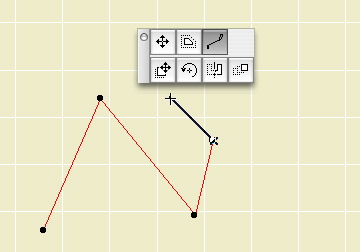
Add to polyline
If you click on this button, you can add nodes to the polyline. Good feature, half-implemented: You can only add straight segments. Sigh.
In AC9, the pet palettes for the arrow tool transformation functions and the element-specific editing functions have been combined. This is awesome.
Here's the Mesh palette:

In past versions, there was one palette which came up under the arrow tool, which had the dragging, mirroring, etc. buttons. Then for each tool there was a different palette which had the buttons for moving a node, curving an edge, filleting, etc. Now, regardless of whether you have the the arrow tool on, an expanded palette appears which has all the buttons of both groups.
This smoothes out the whole editing process because there's a lot less switching to the arrow tool and back.
They also improved the transformation (rotate, etc.) functions of the palette. Now you might actually use them. If you select rotate or mirror, you can select the base point for the transformation, like with the regular command. In 8.1, these palette functions would take as the base point the point where the palette came up, making them IMHO useless.
Shift-click accumulates selection. (I know shift-click accumulates selection! I know that!)
Prior to ArchiCAD 8.0, the shift-click functionality could be modified by activating Caps Lock. With Caps Lock active, shift-clicking on unselected elements would select the clicked-on element and deselect all others. This was invaluable in getting a particular element out of a pile. But it made newbies cry so they got rid of it. (I was typing, notes, with all caps, an-and, then I went to uh, uh, uh, select, something, an-and, caps lock was still on, an-and, uh, uh, uh, the selection didn't accumulate, an-and, I had to move my left hand a quarter inch, to, to, to, turn caps lock off!!! MMMWAAAAAHHHHH!!!!)
In AC9, they have restored the functionality, while throwing the newbies a bone by not using the caps lock key to do it.
If you hold down Command along with shift, the selection will rotate through the elements at that point. With a particular tool active, it will rotate through the elements of that type. Don't forget Quick Select!
AC9 grants one of my longest-standing wishes: You can set section windows to rebuild only when you say so. Unfortunately, the implementation of the feature isn't perfect. Fortunately, the performance improvements of AC9 make the feature less critical than it was. Now that we have it, we can live without it, and the workflow issues mean we probably should.
In AC8.1 and earlier, the sections would rebuild if there was any change in the model, even if the change didn't effect the section in question.
They also rolled the drawing (unlinked) section functionality in with the other rebuilding options, so that process is slightly different.
The rebuilding options are contained in the settings of each section independently. In the section settings you see this:

Autorebuild Model is the old way, and the default. You open the window, it rebuilds.
Manual-rebuild Model means the window won't rebuild until you say so. Note: The command to rebuild a manual-rebuild section is different from an ordinary 'Rebuild'. The command is Display -> Section/Elevations -> Rebuild from Model. It has a different shortcut, Cmd+Opt+R. Even more confusing, for an autorebuild section, the standard rebuild works as always.
Drawing is the same as the old 'unlink'. To turn a section into a drawing, select this option. The Unlink command is gone. The advice about dragging a copy in a section drawing window still applies. You can turn a drawing section back into a model, but ArchiCAD will delete all the 2D elements that it initially drew. You can update the drawing, keeping it a drawing, with the Rebuild from Model command, Cmd+Opt+R, as with the manual-rebuild model.
So the manual-rebuild model should save a lot of time, let's do it. Not so fast. We hit the wall when we go to PlotMaker. As of now there is no facility to tell PM to update a manual-rebuild section window. That means you have to, well, manually rebuild the section before updating the view in PM. That means you have to remember. That means sometimes you'll forget. That means you'll have drawings you think are updated but aren't. The word for this is 'bad'.
Another option is to turn the section back into autorebuild before going to PM, but you'd have to remember that too.
As it stands, manual-rebuilding will save you time in ArchiCAD at the risk of de-automating part of the layout book. As such, I can't recommend the manual-rebuild section functionality until the PM problem is solved.
Quick Selection is the ability to select elements in the plan and the 3D window without finding a detectable edge or node. (The 3D window has had this feature for while, it just didn't have a name.)
With Quick Selection active (it is technically optional), you can click anywhere on on element to select it, either with the arrow tool or by holding down shift. It works for all elements, including objects. (Assuming the object contains polygons.) Example: Rather than finding the corner of the bathtub and then scrolling the pile of elements occupying the corner, just click in the middle of the tub.
Successive clicks will scroll through the elements in a given area. Successive shift-clicks will accumulate the selection.
The QS status is shown by the button at the top of the info box:

The Quick Select button. The magnet thing.
While QS is active, if the cursor is over a selectable element, the pointer will have a magnet attached to it, like the magnet on the status button.
You can temporarily suspend QS by holding down the spacebar. You'll need to do this to select with a box where the cursor is a magnet.
I have never deactivated QS, and I don't recommend doing so. Following this advice means some habit-changing.
In practice, especially in section or model layer combinations, the magnet cursor will almost always be on, because you will almost always be over something selectable. If not a fill, a slab, if not a slab, then the site mesh. This means: You will find it nearly impossible to deselect by clicking in "empty space", because there isn't any. In fact, it's worse than that. As you casually click on you floor slab, not realizing it, you also begin to drag it. Eek.
Quickly develop the habit of using esc to deselect. As you develop the habit, pay attention and watch for unintended drags. Don't give up! QS saves lots of aggravation once you get the hang of it. Resist the evil voice in your head telling you to turn QS off and go back to the old way. If I was training a new user today, I wouldn't even tell them about deselecting by clicking nowhere.
AC8 brought esc-to-cancel, a standard functionality in most software. In AC9, esc is way more useful.
Esc will activate the arrow tool. Unless...
There's a marquee present. If so, esc removes the marquee. Unless...
Elements are selected. If so, esc deselects. Unless...
There's a command in process. If so, the command is canceled.
In other words, with a command in process, a marquee present, and a non-arrow tool active:
The first escape cancels the command. The second deselects. The third removes the marquee. The fourth activates the arrow tool.
Former autocad users will want to redevelop their "esc-esc to cancel-deselect" habit.
Further strikings of esc in future releases of ArchiCAD will close the project, quit ArchiCAD, shut down the machine, and drive you home. Maybe.
You wish you could turn (e.g.) a solid door into a french door while maintaining the other settings (trim etc.). Well wish for something else.
Select an object and open the settings. Navigate to the object you want. Hold down Command and Option and click on the new object. Any parameters the two objects have in common will hold their values. Parameters in the new object that aren't in the old one will keep their default values.
In our door example, all of the settings related to trim, materials, open angles, etc. will be saved. The divisions of the french door will be the default divisions.
Very exciting.
ArchiCAD 9 was officially announced at ACUE in Nottingham last week. It is expected to ship around September 27. We will be deploying the upgrade soon, but not immediately. More on this later.
As you may know, I had the privilege of participating in the beta test program for the new release. Graphisoft also had the privilege of having me participate. ;-) This is good for us since I have had a long head start in preparing for the update, so we will be able to hit the ground running.
We all remember, try as we might to forget, the transition to AC8. It was extremely difficult on a number of levels, and honestly you don't know the half of it. The difficulties had two main causes. First, the program had been radically redesigned and rewritten under the hood. Second, it sucked. The latter in particular was a big problem.
I can tell you with complete honesty that AC9 doesn't have either of these problems. There are no radical changes to the program, though there are several valuable new features. (Many argue, and I might be one of them, that the version should be called 8.5. Whatever.) More important, the quality, speed, and stability (non-crashing) of this release are far greater than the early releases of AC8. In Nottingham, Graphisoft showed us benchmarks which indicate that AC9 is the first version since AC7 to be faster overall than AC7. The performance improvement is noticeable.
Further, while this may not interest you, it certainly affects you, Graphisoft's internal procedures have made a 180 degree turn for the better, making another AC8 disaster very unlikely. Mainly because everyone involved with AC8 has been fired. Really. In the beta testing I observed first-hand a much improved quality-control policy, and a real interest in hearing from users and addressing their concerns.
Since AC9 isn't much different in the nuts and bolts, we will be able to transition quickly without undue disruption to workflow. Unlike with the AC8 transition, we will not meditate on whether to move a project over. It will be moved over. Assuming Salamander Farm goes the way of all flesh, we will soon be running only one version of ArchiCAD.
I am working on polishing the new templates, library parts, and the upgrade procedure itself. Once this stuff is to-a-point, we will set a date to do the move. I will be posting here on some of the new features for reference, and I envision about two tech meetings on the essentials. Graphisoft has done well in releasing an easily-deployable update, and I don't want to be the one to mess it up!
Attribute Manager is a utility for managing (creating, deleting, getting from somewhere) attributes (pens, layers, layer combinations, materials, linetypes, fills, composites, locations, zone categories). Its functions overlap with the individual attributes dialogs accessed from the Options menu. But it does at least two unique and indispensable things:
• Tells you if an attribute is in use before you delete it.
• Enables you to quickly, directly get attributes from other projects.
We will look at how to get a composite from another project into your own.
v2 is here. It seems to work.
Two gotchas so far (maybe you'll be lucky): 1) In PM, after stretching a frame with the arrow tool, frame nodes will not be detectable until you rebuild. Scroll-zooming forces a rebuild so that takes care of it. 2) After rebuilding drawings via drawing usage, the layout window becomes unresponsive. Minimize the window to the dock using the yellow title bar button. Bring it back, and it's OK. I think GS's beta testing consists entirely of demonstrating the software to their dogs. I digress.
The howto follows.
The project templates' plan window now has a drawing area object and corner alignment hotspots for each sheet size. Delete the ones you don't need. Move the object around to center the plan, then move the hotspots to the corners on each story.
But you don't use the drawing area and the hotspots to align the plans in PM so the plans stack in a professional and aesthetically pleasing manner? Well you better start.
Intersection group number is an AC8 feature that controls which layers clean up to each other. If the numbers match, they do, if not, they don't.
Which you need to do from time to time, for several purposes.
Don't.
Remember our layer system is the result of lots of work on lots of simultaneous problems. As such, it is hard to improve but easy to break. Trust me. Further, layer management is far and away the most unpleasant standards task in the whole operation. You don't want to get involved.
OK, sometimes you have to. Maybe you really need a new layer. Maybe I told you you need one. If you're going to do it, you'd better do it right.
Select an existing LC that is similar to the one you need to make. Click 'New'. (The other one. Lower left.) Put in the new name. Make changes to the showing and hiding of layers on the right. Click 'Update' at the bottom. OK and save.
You will probably need to create views for the new LC.
See also:
Creating Layers
On the ArchiCAD Help Menu, beneath the first two items, you will find two lists of items.
The first list consists of links to PDFs, including the ArchiCAD manuals. The PDFs reside in the Documentation folder within the ArchiCAD folder. Any PDF placed in this folder will appear in the menu.
The second consists of links to web sites. The links reside in the WWWLinks folder within the ArchiCAD folder. Any link placed in this folder will appear in the menu.
Favorites are preset configurations of the tools. They enable you to quickly configure a tool for a given purpose, like option-clicking without the need for a placed element.
I have never developed a strong affection for them, for several reasons. They were terribly implemented when they started, in AC6.5 if memory serves. Until AC8, there was no button for favorites in the settings box (?!!). Finally, in a far-along project, option-clicking is still the fastest method. Modules are also nice.
In AC8 the feature is mature enough that I can recommend you try it.
Update: I have expanded on this topic here". I have strikethrough'd the really wrong bits here.
(I am planning a tech meeting for this topic the week of the fifth.)
Q What is a detail window.
A new kind of window in AC8. A hybrid of a section window and a patch.
Like a patch, they can be generated from existing geometry. Like a section, they can be renewed. Unlike a section, they cannot be model views, only drawings.
Q What are they for.
At 3 Resources/AC Program Files you will find AC8.1 v1 1410 USA Updater, an update patch for 8.1. Go ahead and run it. It requires a restart. I have no idea why.
Forgot something else...
In 8.1, we have the option of placing a marquee to limit the print area, instead of fiddling with the window itself.
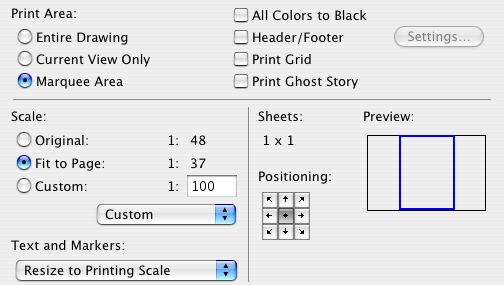
Print Marquee Area, among other things.
Click 'Copies and Pages' and select 'ArchiCAD' to view these options.
As far as I know, this option has always existed, but I've only fully internalized it recently.
Try this display option in your working plans and sections views:

Uniform Solid and friends
It causes walls in plan, and all elements in section, to display as solid fill of the pen of the fill pattern. In plan, this means that only the corner of the wall itself can be detected, not the inside drywall corner. This eliminates the problem of accidentally aligning counters, floor fills, and such to the core of a stud wall.
I have taken the liberty of changing the working views in the templates to employ this option.
This is about four years old but I wanted to explicitly point it out...
All the attribute-related options on the Options menu (Pens and Colors, Line Types, etc.) use the Ctrl+Opt+Cmd modifier combination with the initial letter of the attribute.
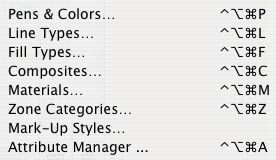
I'm sensing a pattern.

Oh! Those three.
Obsolete. We're not using cach libraries at this time.
It's good to have the libraries on the server so we are all up to date all the time. But loading libraries from the network is slow. This is a big problem when updating views in PlotMaker. The satellite library is an attempt to have it both ways. It has been bumpy in the past, but I've tried it again and can cautiously recommend it.
Forgot something...
The copy transformation modifier key is now Option instead of Command. Instead of drag a copy being Cmd+D+Cmd, it's Cmd+D+Opt. Same for mirror and rotate.
Window | Floating Palettes | Show Quick Layers (Ctrl+L).

Quick Layers Palette
The Quick Layers palette enables you to:
Unhelpfully:
� Toggle the display of all the layers. All the showing layers become hidden, all the hidden layers show. Shrug.
� Ditto for lock/unlock. Shrug.
Very helpfully, under 'Selection's Layer':
� Hide, lock, or unlock the layer of selected elements, even for multiple layers at a time. Similar to the 'Layer' sub-context menu.

Remember?
Unhelpfully again:
� Hide or lock all layers. Big shrug.
The palette will close when you quit ArchiCAD, unlike the standard palettes. Just reactivate it when you start with Ctrl+L.
AC8.1 improves Composites substantially. A summary.
Starting Monday, Dec. 8, we will be moving to ArchiCAD 8.1 and PlotMaker 3.1. This is a relatively minor feature update, with noticeable performance and interface improvements. No, it's not perfect, but it is better. Unlike the 7 to 8 update, we will move current projects over.
Don't forget: In AC8, the escape key now performs the cancel function. This makes it consistent with all other software in the solar system. 99% of the time, hitting ESC will be faster than mousing over to the Cancel button, or right-click-canceling.
It's also another beautiful, inspiring, timeless, indestructible tower on the magisterial edifice that is The Keyboard, as compared to the moldy-straw-1st-little-pig-shack of Mousing Around Clicking Buttons, Menus, Sub-menus, and Sub-sub-menus.
In other words, learn the shortcuts, and use them. And we'll plan our escape.
Tech Meeting Notes, ArchiCAD 8 Navigator, July 29, 2003.
Here's a summary of the single key commands in ArchiCAD. I didn't know some of them either. G & C will save you a lot of mouse milage.
- A - Activates the Angle Coordintate
- B - Activates the Base Value (in the Info Box)
- C - Cycles through the Construction Methods
- D - Activates the Divisions Snap Option**
- G - Cycles through the Geometry Methods
- H - Activates the Angle Bisector Modifiers**
- O - Activates and switches between Offset and Multiple Offset**
- P - Activates and switches between Parallel and Perpendicular Modifiers**
- Q - Cycles through the Quick Alignment Methods (when Shift-constraining)
- R - Activates the Radial Coordinate
- S - Cycles through the Grid Snap Options (former esc function)
- T - Activates the Top Value (in the Info Box)
- X - Activates the X Coordinate
- Y - Activates the Y Coordinate
- Z - Activates the Z Coordinate
- 2 - Pans Left
- 4 - Pans Down
- 6 - Pans Right
- 8 - Pans Up
** Broken in OS X. Too bad, epecially P.
Purpose and locations of the ArchiCAD and PlotMaker preferences, and why you care.
There is an issue in AC8 v3 where certain details can not be deleted or renamed. Graphisoft Tech Support has provided a solution.
I have fixed the templates, so this shouldn't be a problem for new projects, but I'm sure there are some running projects that need to be fixed.
When installing ArchiCAD, don't do the Easy install. Custom install is faster and saves space.
This is a reprint of the notes for the Libraries & Objects tech meeting a while back.
I have announced this before, but just to reiterate, emphasize, clarify...
New projects should be begun in ArchiCAD 8.